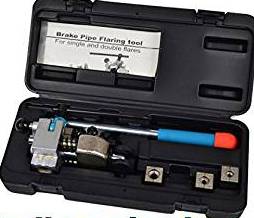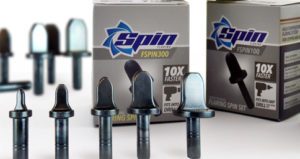Best Flaring Tool HVAC
Eugene Trotsmans,
10-01-20
Working in the heating, ventilation, and air conditioning industry requires the use of many tools and best flaring tool HVAC is a must have to create a cone-shaped enlargement at the end of a piece of tubing to accept a flare fitting.

OUR CHOICE – Best Flaring Tool HVAC
Most of the HVAC flare fittings are 45° rated for use with high-pressure refrigerant. Selected fittings should also comply with local, state, or federal standards.
Copper tubing types are: “K” – thick wall, hard; “L” – medium thick wall, hard; “M” – is thin wall tubing used for drains and plumbing. Refrigeration tubes are measured by outside diameter (OD): ¼, ½, 5/8, ¾, 7/8, 1-1/8, 1-3/8, 1-5/8, etc. Plumbing tubes are measured by inside diameter (ID): 1/8, ¼, ½, ¾, 1, 1-1/4, 1-1/2, 1-3/4, and so on. When flaring ¼” and smaller pipes the exposed pipe to be flared should be set above flaring block about the thickness of a dime, for 3/8″ and larger – about the thickness of a nickel.
SAE 45° flares are used widely in air conditioning systems. The fitting is used typically for low-pressure applications, in most cases with soft aluminum or soft copper tubing, which easily flares to the 45° angle. These fittings are commonly used in the following applications:
-ice maker connections;
-natural gas appliance hookups;
-refrigerant lines.
| Product | Features and short review |
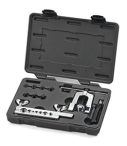
|
SAE 45° flares up to 0.040 wall thickness. Tubing sizes: 3/16″, 1/4″, 5/16″, 3/8″. 7/16″, 5/8″, and 1/2″ The tubing bar steel is not hard enough. The bar cannot hold the tube because of great deformation. The tail to use it in a vice could be longer to get a better grip. It is a chip kit for occasional home use, it can be difficult to achieve good flares. However, with the technique it does work. |
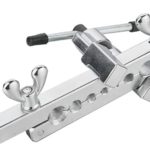
(all three styles on one page) For flaring copper, aluminum, brass and thin wall tubing 45°
|
Features a steel yoke and hardened bars. This tool works, but it is not a high-end one that would last long. The General tools are pretty compact, but they has some engineering flaws. The bars flex when the clamp is tightened, and since it puts pressure on the edge of the die blocks, they do “splay” out. This results in a small pinch line either side below flare. Dies that hold the pipe are slightly out of round, deforming the flare. The dies are loose in the tool and do not align horizontally or vertically. |

(all three styles on one page) Makes 45° single flares
|
General tool flaring devices do their job but that the very ends of the flared tubing are too rough. It makes a “usable”, but not a perfect flares. These tools are an option if you use it seldom and need something inexpensive. For better results insert the tubing into the tool so that about 3/32″ extrudes out of the tool (you can use a 5 cent nickel – the tubing must be just below the height of the nickel). Tighten both screws alternate, both halves of the tool must be even in height. Apply a small amount of or grease to the mating face of the flare. |
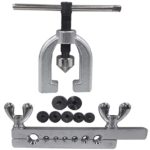
(all styles on one page) For aluminum, copper, brass and thin wall tubing |
It works, but if you have ever used a professional tool, you will be disappointed. Haumtec is designed economy grade. It is not so reliable and convenient. Wing nuts require something to provide extra leverage to tighten blocks together, the holes in the bar leave marks on the tubing that make it difficult to get the flare nut past. |
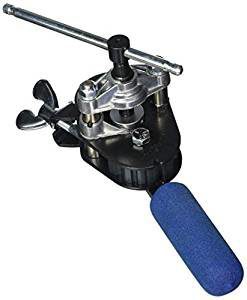
OUR CHOICE – Best Flaring Tool HVAC Yellow Jacket 60278 Flaring Tool For aluminum, copper, and brass tubing |
Nice quality tool made in the USA. It barnishes the copper and flares at the same time. I really like one-piece construction of the Yellow Jacket, it is very nice. Depth gauge helps to make excellent flares every time you use the tool. Splitting flares due to over cranking is almost impossible. Flares are very smooth. If you do refrigeration or install mini splits, this tool is a must-have. And it would work great for water or gas lines as well. Cons: difficult to oil and clean the flare cone due to restricted access |
Flaring tools for brake lines

OUR CHOICE – Best Flaring Tool for Brake Lines
Everything low pressure (<1000psig) from oil and gas lines to service ports, refrigerant line fittings, and flares, the fitting and hoses on your manifold, are all SAE 45°. The main exception is automotive brake lines (also 45°, but with a double flare system) because they have the “male” end of the fitting junction.
If you work with brake lines often, you need professional flaring tool. I recommend the Mastercool flaring kit. It is very precise and reliable, you may find a lot of good online reviews. Despite the cost, it is the full kit to use on the brake projects. The flares made with Mastercool kit are of comparable quality to the factory ones. Moreover, making consistent flares is easy.
There are many cheap $20-$30 flaring tools available. If you need a tool for occasional use, you will make usable flares with the cheap set. The flares often will not be consistent, and sometimes you will redo the connections.
Mastercool flaring kit
The kit fabricates Push Connect Flare: 3/8″, 5/16″ and 1/4″;
GM Fuel Line Flare: 3/8″ and 5/16″;
Flare and Double Flare 1/2″, 3/8″, 5/16″, 1/4″ and 3/16″;
Metric Bubble Flaring 10mm, 8mm, 6mm and 4.75mm.
If you work with brake lines often, you need professional flaring tool. I recommend the Mastercool flaring kit. It is very precise and reliable, you may find a lot of good online reviews. Despite the cost, it is the full kit to use on the brake projects. The flares made with Mastercool kit are of comparable quality to the factory ones. Moreover, making consistent flares is easy.
You’ll also like the variety of dies available, the full kit comes with a good to start set, and although the tool is a bit clumsy for use in confined areas, I like the tool and recommend it. The Mastercool flare tool works perfect, and in my experience, nobody goes back to cheap tools after the kit.
Mastercool kit (operating instructions, flier) fabricates:
-push connect flares (3/8″, 5/16″ and 1/4″); GM Fuel Line Flares (3/8″ and 5/16″);
– flare and double flares (1/2″, 3/8″, 5/16″, 1/4″ and 3/16″);
– metric bubble flaring (10mm, 8mm, 6mm and 4.75mm)
– weight: 11 pounds
– dimensions:15 x 10.3 x 3.2″
– steel Exterior
– comes with custom molded carrying case
You’ll also like the variety of dies available, the full kit comes with a good to start set, and although the tool is a bit clumsy for use in confined areas, I like the tool and recommend it. The Mastercool flare tool works perfect, and in my experience, nobody goes back to cheap tools after the kit.
Rigid flaring tool
Model 345/145M is a precision tool for producing 45° flares in soft brass, copper, mild steel and aluminum tubing.
Manual Flare Tool:
-No. 377: 3/16″;
– 3/4″ (37°);
-No. 458: 1/8″ – 3/4″ (45°);
-No. 458M: 4 mm – 16 mm (45°).
Ridgid ratcheting flaring tool comes in both the 45° and 37° flavors. The Ridgid is pretty good, and costs less, than a Mastercool.
The 345-DL kit comes with the double lap adapters and is suitable for brakes. You can use it on a car and motorcycle brake lines will do fuel line as well.
Without double lap adapters – the 345 kit – is for making single flares and do not suitable for brake lines
The quality is very good, and Rigid have
a full lifetime warranty. The cone self-centers in the tubing and then you just tighten the flaring tool onto the tube block and after a few cranks of the lever out comes the perfect flare connection.
When working with the tool under a car, it is hard to begin working until you can get it screwed down.
Most likely, you will not be able to make a 3/16 line double flair alone with this tool. The other dies have serrated jaws for holding the tubing from slipping, but the 3/16 die is smooth and pushes out while setting the first flair. But then it was built for the copper/plumbing trade, and car guys need a good flair tool for brake lines.
- Eccentrically-mounted, hardened steel flaring cone
- Shows measurements in both metric and inches sizes
- Lifetime warranty against defects in material or workmanship
Notice the Flaring Cone is eccentric. It has 2 bearings, one under the cone, and another set of roller bearings surrounding the shaft, these work together to produce very high-quality and consistent flares with minimum hand effort.
Stainless takes great effort to turn the handle, and bending the stainless is often harder than doing the flare.
It is well designed, very strong tool and you can buy replacement parts. If you are going to use this with just copper tubing you have a tool that will last a lifetime.
The tool is ease of use; makes consistent flares on multiple materials in multiple sizes.
Inline tube – Best flaring too for brake lines
Double Single Metric & Standard 45 Degree Professional Brake Flaring Tool Set (C-1-2) works with lines:
Double Single Metric & Standard 45 Degree Professional Brake Flaring Tool Set (C-1-2)
Flares both OE steel, stainless steel, copper, and aluminum

OUR CHOICE – Best Flaring Tool for Brake Lines
- lines 3/16″, 1/4″, 5/16″, 3/8″
- Bubble ISO Metric 10mm, 8mm, 6mm, 4.75mm (3/16″)
- Both Metric and Standard Unique Clamp with removable tooling.
- Includes yoke assembly, 8 adapters, handle and bar assembly in a molded storage case
With the kit you can flare anything from brake lines to transmission cooler lines and fuel lines. Handles 3/16. Forms 45° double and single flares & Metric Bubble Flares.
Turret style design allows making quick and easy precision flares in no time. It is intended to be used while held in a vise. Trying to use it without it being firmly held in place would likely not only be difficult but also produce a lower quality flare.
The tool looks a lot like the Eastwood 25304 Kit and the quality is awesome. I used it many times now even on stainless and it has worked great!
37° Flaring Tools
37-degree SAE flares in 3/16-inch, 1/4-inch, 5/16-inch, 3/8-inch, 1/2-inch, 5/8 and 3/4-inch sizes
OUR CHOICE – Best 37° Flaring Tool
37° JIC is intended generally for high-pressure applications in pneumatics and hydraulics.
AC flare fittings (30° flare angle) were developed in the 1930s, and have been replaced with AN and are a rare find today. Some people may use the term “AC Flare” when referring to SAE 45° fittings.
AN / AND fittings (37° flare angle) traditionally available in carbon steel, aluminum, stainless steel, and titanium. Remain in prevalent use today. The AN and MS designations for many fittings are being superseded with AS (Aerospace Standard).
SAE 37°, JIC, Parker Triple-Lok, ISO 8434. This is generally what somebody is talking about when says it’s a JIC fitting. This is the general industrial version of the AN fitting. These fittings have a class 2A/2B thread with normal trapezoidal root truncation.
Our recommendation here is Ridgid flaring tool. It makes 37 degree flares only, AN, not for double flares. The tool has as a “torque setting” – once the flare is done the torque setting breaks free preventing you from overdoing the flare. Cover sizes: 3/16, 1/4, 5/16, 3/8, 1/2, 5/8 and 3/4.
With Ridgid you can make flares in stainless. At least on 3/16″ brake lines, larger or thicker stainless is possibly going to take concealable more effort to turn the handle. Stainless is pretty hard, but flares are great, much better than putting the fitting on before flaring 🙂
| Product | Features and short review |
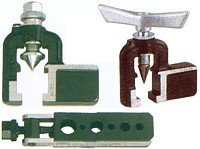
Aircraft Tool Supply Imperial Rol-Air 37° Aviation Tube Flaring Tool Kit Flares both OE steel, stainless steel, copper, and aluminum |
Rol-air tool forms AN single flares. They are perfect in regular and stainless steel lines. Roller action cuts effort required; maintains original wall thickness – eliminates stress concentration. Extension on the yoke for clamping in a vise. Satin chrome and black finish. Includes tool case. When working with stainless tubing, do not use a conventional tube cutter, it would pinch down the diameter and very quickly “work Better to cut the tube in the flaring toolbar. It is made of very |
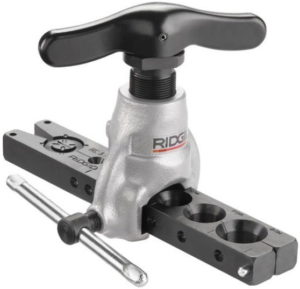
RIDGID 41162 377 Precision Non-Ratcheting Pipe Flaring Tool, Flaring Tool for 37-degree SAE Flares Flares both OE steel, stainless steel, copper, and aluminum – 37° SAE flares in 3/16, 1/4, 5/16, 3/8, 1/2, 5/8 and 3/4 inches |
For the price you can’t go wrong, the tool does a great job even on stainless tubing. Eccentric rolling mechanism forms the flare very precisely. Ridgid flaring tool has the bar clamp on the side of the flaring chuck, so you’re getting a positive clamp on each particular tube, no matter no matter which tube size you use. The bar is will not bow in the middle, and you don’t get a positive grip on the tube. The ratcheting handle breaks free when its reached a pre-determined flare point on the tubing, so you don’t over or under tight the flare. The preset is perfect for .250″ OD / .035″ W tubing. Some materials need the right amount of flare. If you push aluminum tube to the recommended point, the flare becomes so large that the nut will not go over the flare. Once you figure this out it works well. |
Drill Bit Flaring Tools
Flaring drill bits are a new concept in flaring. They able to easily flare aluminum or copper tube, in just a few seconds.
You only need to use it with a hand drill. The flaring tool uses a high-temperature technology, due to friction
between the tool and a metallic tube.
The flaring bits are designed to work with a minimum of 1,800RPM and 18V for cordless drills or 500 watts for corded drills. With less powerful equipment the tool may result in significant decrease in performance.
The Flaring tool drill bit is designed to work with copper
tubes of 3/8”, 1/2” and 1/4” with a wall thickness of up to 0.8mm (for 3/4” and 5/8” tubing – up to 1.0mm) diameters.
The tool makes flares fast, and it doesn’t remove any material. It doesn’t leave any burrs or shavings of copper or aluminum. Makes a nice clean flare that conforms to the fitting. The bit gets hot in the process, it is enough for getting hurt but isn’t enough to do hard drawn copper.
Cons:
– it would be nice if each flaring tool was labeled with sizes;
– you have to hold the drill perfect straight to make a good flare;
– with the 7/8″ you need a little muscle. A cordless drill will drain a battery very fast, better use a corded drill for 7/8″ flares.
Update (2020): More Great Flaring Tools
3/16″; 1/4″; 5/16″; 3/8″; 1/2″; 5/8″; 3/4″
The Hilmor orbital flaring tool produces nice quality flares, has built-in tube stop and built-in clutch. The built-in tube stop slides over so when you slide the tube in, it stops flush with the top of the bar. Excellent clutch mechanism stops compressing when the flare is done. With proper use, it will create perfect flares with no leaks.
Cons: it costs more than Rigid 345 flaring tool.
Imperial 500-FC has 45° hardened steel, faceted, chrome-finished cone rolls and heat treated dies.

